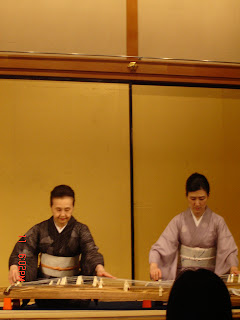Tea is an interesting subject to talk about because it differs greatly in a way to produce and take in each country and region.
In case of Japan, we traditionally consume green tea, the tea streamed and dried right after leaves are picked. Green tea is non-fermented and therefore, it keeps its original color, good effect and power to sustain our health.
The most common way of consuming tea is to influse tea leaves in a couple of minutes in boiling water and extract flavour and aroma. You pour the hot water into a cup. The tea leaves are filtered out and therefore you do not take them. This is same as you drink British tea and other European style tea.
Matcha (抹茶) is unique because it is different in the way to prepare and to be taken. To make matcha, we use tea in the highest quality. Once leaves are steamed and dried, they are ground into power by millstone. Tea power is placed into a bowl and boiled water is poured into. Matcha is the only tea in which you take tea leaves directly.
Matcha has two distinctive types : One is "koicha (濃茶)", which literally means "thick tea". The other is "usucha (薄茶)", which is a ligher tea. If you are interested more, you may take some tea ceremony lessons, an instructor will explain it.
I show you how "Koicha" look like in picture. As you can see in the picture below, it is really thick. It tastes really bitter. I love "double espresso" without sugar and I usually take it after a meal. For even someone who really like bitter taste, "koicha" is a bit too much. So, I do not recommend it for ordinary people. But do not worry. Tea houses for ordinary people serve "usucha" as "matcha".
The next one is "usucha". This is the one that you normally get when you order "matcha".
Matcha always comes with a small portion of "Japanese confectionary" like below:
We, Japanese do not take suger in our tea. Instead, we take sweet like this. Westerners often find Japanese traditional sweets too sweet for them to take. Intead of taking suger in tea, we take a rather sweet confectionary together. It can be said that we, Japanese enjoy a contrast in meal. In this way, we can appreciate each dish and drink.
This is mochi, a Japanese rice cake made from glutenous rice. In the center, it contains a filling
called "an (餡)" or "anko (餡子)", made from "azuki" red bean paste (小豆餡)with suger. It is covered with soybean power called "kinako (黄粉)".
I went to a traditonal tea seller's called "ippodo (一保堂)". The shop is in a tradtional Japanese house and it also run a "modern cafeteria" where they serve tea and sweets. The reason why I said "modern" is that customers can enjoy tea at table by sitting on a chair instead of folding their legs on "tatami" floor.
一保堂本舗 本店
京都御所の南北に走る寺町通りに面している本店。 あたりには骨董屋さんや画廊が並び、京都らしさにあふれています。
住所 :京都市中京区寺町通二条上ル常盤木町52
TEL :075-211-3421
営業時間:午前9時から午後7時(日祝は6時まで)
店休日 :正月
サイト :http://www.ippodo-tea.co.jp/
Next, I introduce you another type of tea called Hojicha. Hojicha is roasted tea, reddish-brown in colour. When you infuse green tea, you first place tea leaves in a pot and then pour hot or boiled water. You wait one minute or so, so that taste and aroma of tea are extracted and stay in water. You must pour the tea into a cup on time, otherwise your tea becomes too bitter to drink.
In case of hojicha, roasted tea, you do not have to consider this risk. You can pour the tea out into a cup right after you finish pouring water into a pot. And you can use the tea leaves a few times after your first pour.
You enjoy roasted aroma and thick taste.


















































